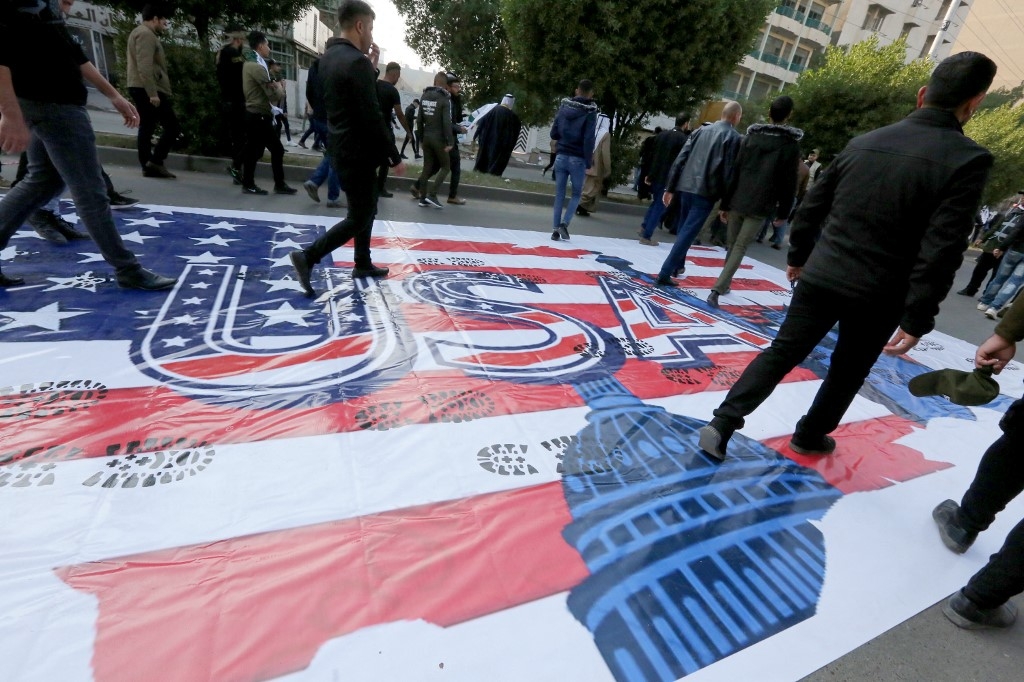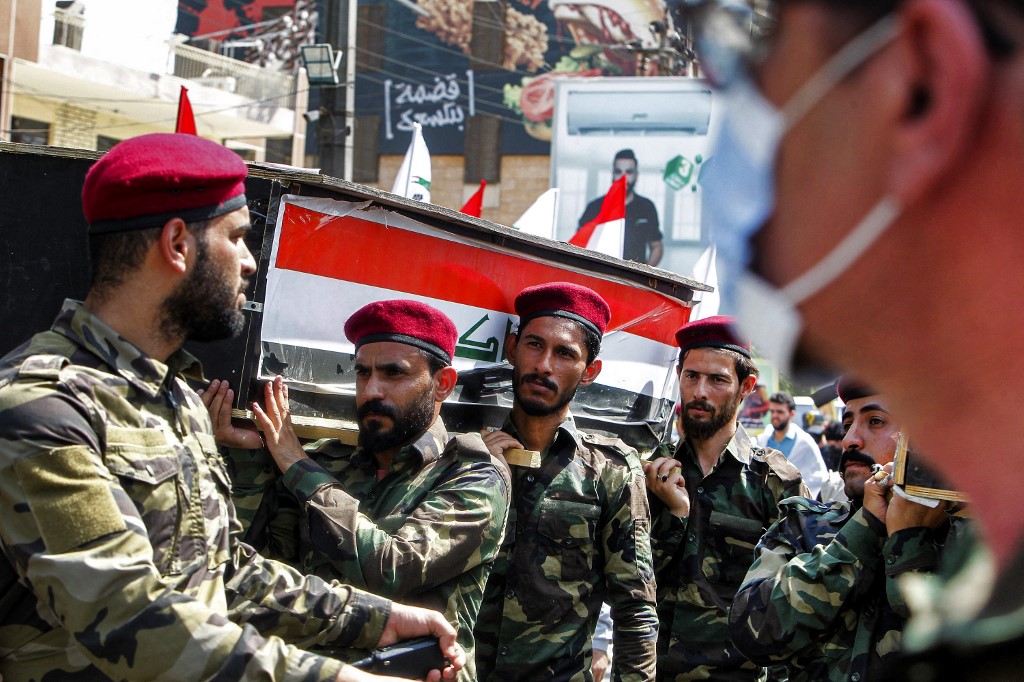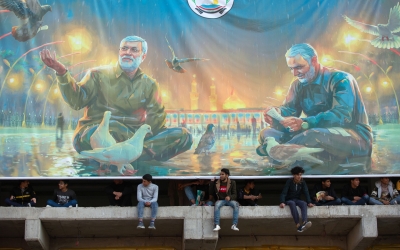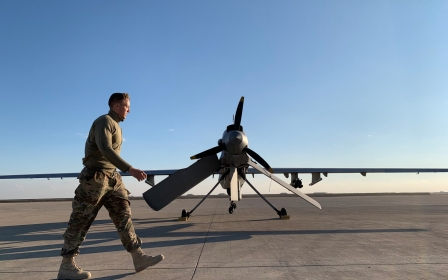Iraq: How Iran-backed paramilitaries are testing US resolve

Late last month, US warplanes struck positions on the Iraq-Syria border, targeting two brigades of Iraq’s Popular Mobilisation Forces (PMF), Kataeb Hezbollah and Kataib Sayyid al-Shuhada. The PMF is an umbrella state institution for paramilitary forces, many of which identify themselves with the Iran-led “axis of resistance”.
The US strike is the second of its type against PMF brigades since President Joe Biden took office, in a trend that is likely to increase. The strike, which killed four PMF fighters, came in the wake of drone attacks by paramilitary groups against crucial positions for US and coalition forces in Erbil, the capital of Iraq’s Kurdish region. Drones have increasingly been used for anti-coalition attacks this year.
The PMF is a human reservoir, financial coffer and institutional cover, which paramilitaries are attempting to shield from direct tit-for-tat attacks
After the US strike, the Iraqi Resistance Coordination Commission (IRCC), representing a number of Iraqi paramilitary groups, swiftly promised retaliation. The commission, which first appeared in October 2020 to cement a unified paramilitary position against the US, issued its condemnation even before the PMF had formally done so.
The PMF is a human reservoir, financial coffer and institutional cover, which paramilitaries are attempting to shield from direct tit-for-tat attacks – and this is where the IRCC comes in. Yet the more paramilitary bodies there are, the more likely it is that power centres will evolve, increasing the potential for rivalries.
Shortly after the US attack, paramilitary groups between 28 June and 7 July reacted by launching at least six attack attempts using rockets and drones against US military positions in the al-Omar oil field in northeastern Syria, Ain al-Asad in Anbar, the US embassy in Baghdad, and the Erbil International Airport.
Warfare capabilities
Iraqi paramilitary groups operate within a regional axis of multiple actors who enjoy varying military capabilities sourced from Iran. Tehran’s Islamic Revolutionary Guards Corps’ Quds Force is increasingly supplying allied groups with high-precision missiles and drones. Most of the groups have also developed their own paramilitary capabilities, building on Iran's assistance and innovating on their own terms.
Several factors shape the supply of weaponry and the frequency of their deployment. Chief among them is Iran's perception of the potential of, and need for, armed deterrence in each theatre, and the theatre's geographic accessibility – whether blockaded like Gaza and northern Yemen, or surrounded by permeable borders, like Iraq and Syria.
In addition, the diversity of theatres within which the groups operate allows the Quds Force and others to monitor the effectiveness of the weaponry, in a continuous process of battlefield learning.
Drone and rocket attacks by Yemen’s Houthis against Saudi targets have been complemented in recent months by increasing paramilitary drone attacks from Iraq. Successful rocket attacks by Hamas and other Palestinian groups against Israel this past May also provided support for Iran’s regional axis.
Such prolonged conflicts enhance competitive and collaborative dynamics among a plethora of actors in acquiring weapons from Iran, developing their own, sharing experiences, and even coordinating attacks.
In June 2020, Kataeb Hezbollah announced that it was entering into a “deterrence equation” that obliged it to take part in war with Israel. Iraqi paramilitaries are keen on strengthening the transnational dimension of their operations, in part because it helps them to train on different battlefields and to further develop their equipment.
As many Iraqi fighters have returned in recent years from Syria, where regime forces have captured key opposition and Islamic State strongholds, Iraqi groups are seeking new opportunities to deploy abroad, which in turn allows them to strengthen themselves back at home.
Domestic cleavage
When Iraqi forces in May arrested PMF commander Qassim Musleh, allied Iraqi paramilitary groups alleged that the US played a role in his arrest. In their battle with Iraqi Prime Minister Mustafa al-Kadhimi, these groups increasingly view the US as a crucial opponent. They believe that if they can expel US forces from Iraq, they will preempt the Iraqi state’s efforts to harass and undermine them, especially before the October elections, which these groups want to use to remove Kadhimi from office and cement their own influence.
In addition, Iran is striving to push US-led forces out of Iraq before nuclear talks progress further. A complete withdrawal would neutralise a potential joint US-European scheme to negotiate with Iran on its regional and ballistic-missile policies, either coupled with advanced talks to revive the nuclear deal or at a later stage. Iran’s president-elect has, however, expressed that this issue is “non-negotiable”.
Western powers are aiming to revive the nuclear deal before Ebrahim Raisi takes office and appear keen on holding Iraqi elections on time in October, hoping to change the parliament’s makeup against paramilitary-linked politicians who are allied with Iran.
Therefore, by increasing lethal attacks in Iraq, thick-skinned and patient Iranian and Iraqi paramilitary groups are testing with higher risks whether the US will be immersed in an escalation spiral that may have knock-on effects on nuclear talks in Vienna - but even more likely, it could lead to a postponement of the Iraqi elections, two processes that western powers are jointly invested in.
Knowing that the Biden administration seeks retrenchment of military deployments in the region, Iran has less to lose from escalation. It is also less likely to suffer human casualties compared to the US in Iraq where Iraqi paramilitary groups increasingly frame anti-US action in Iraq as a local decision over which Iran has little influence.
The views expressed in this article belong to the author and do not necessarily reflect the editorial policy of Middle East Eye.
Middle East Eye propose une couverture et une analyse indépendantes et incomparables du Moyen-Orient, de l’Afrique du Nord et d’autres régions du monde. Pour en savoir plus sur la reprise de ce contenu et les frais qui s’appliquent, veuillez remplir ce formulaire [en anglais]. Pour en savoir plus sur MEE, cliquez ici [en anglais].







